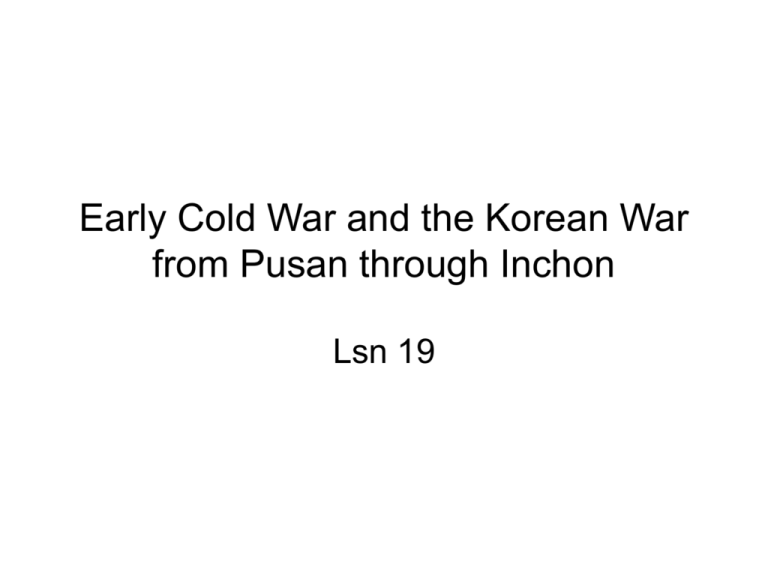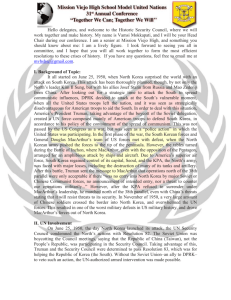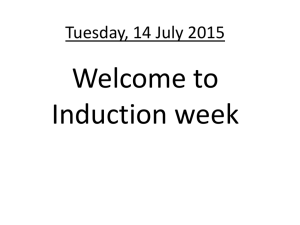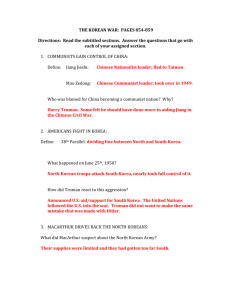Korea: Task Force Smith
advertisement

Early Cold War and the Korean War from Pusan through Inchon Lsn 19 Cold War • A state of political tension and military rivalry between nations that stops short of full-scale war, especially that which existed between the United States and Soviet Union following World War II Iron Curtain • “From Stettin on the Baltic to Trieste on the Adriatic, an iron curtain has descended across the continent. Behind that line lie all the capitals of the ancient states of central and eastern Europe– Warsaw, Berlin, Prague, Vienna, Budapest, Belgrade, Bucharest, and Sofia. From what I have seen of our Russian friends and allies during the war I am convinced that there is nothing they admire so much as strength and nothing for which they have less respect than military weakness.” – Winston Churchill March 5, 1946 George Kennan and Containment • Kennan was a Soviet expert and director of the State Department’s Policy Planning Staff • In the July 1947 issue of Foreign Affairs he wrote an article under the pen name “Mr. X” titled “The Sources of Soviet Conduct.” • He described the USSR as being driven by an aggressive and uncompromising ideology that would stop “only when it meets some unanswerable force.” George Kennan and Containment • Kennan wrote that the US must adopt a “policy of firm containment designed to confront the Russians with unalterable counterforce at every point where they show signs of encroaching upon the interests of a peaceful and stable world.” Greek Civil War • During the German occupation of Greece during WWII, the Communists and other parts of the Greek Left formed a resistance army called the National People's Liberation Army (ELAS) • By 1944, ELAS controlled large areas of the country and continued to have success against the British liberation force after the war Truman Doctrine • On Feb 21, 1947, the British informed the US that they were pulling out of Greece. • On March 3, the Greek government requested US aid. • On March 12, President Truman announced the Truman Doctrine: – “I believe that it must be the policy of the United States to support free peoples who are resisting attempted subjugation by armed minorities or by outside pressures.” Harry Truman JUSMAPG • On 22 May, Truman signed a bill authorizing $400 million in aid to Greece and Turkey. • By 1952, Greek forces would receive $500 million in US aid. • Even more important was LTG James Van Fleet and his 350-man Joint US Military Advisory and Planning Group. Grumman Avengers and Curtis Helldivers aboard the USS Leyte preparing for operations over Greece in 1948 Success • Van Fleet set out to retrain and reorganize the Greek Army and cut off the flow of supplies reaching guerrillas from Yugoslavia, Albania, and Bulgaria • On Oct 16, 1949, Greece’s Communist leaders announced a cease-fire “As in Greece, the enemy strikes from sanctuary” Occupied Berlin Berlin Airlift • In June 1948, the Soviet Union attempted to control all of Berlin by cutting surface traffic to and from West Berlin. • The Truman Administration initiated a daily airlift which brought much needed food and supplies into West Berlin. • The airlift lasted until the end of September 1949 -although on May 12, 1949, the Soviet government had yielded and lifted the blockade. Berlin Airlift The maximum effort of the airlift was the “Easter Parade” on April 16, 1949 when 1,398 sorties (one landing in Berlin every minute) delivered 12,940 short tons. Berlin Airlift NATO and Warsaw Pact • In 1949 the US, Belgium, Canada, Denmark, France, Great Britain, Iceland, Italy, Luxembourg, the Netherlands, Norway, and Portugal formed the North Atlantic Treaty Organization to provide collective security against Soviet aggression • Provided a military and political complement to the Marshall Plan • Greece and Turkey joined in 1952 • NATO admitted West Germany in 1954 and allowed it to rearm • The Soviets responded by creating the Warsaw Pact. NATO and Warsaw Pact Divided Korea • After World War II, Japan’s former colony of Korea was divided into two occupation zones along the 38th parallel with the Soviet zone in the north and the US zone in the south • Before the occupation forces departed, an anticommunist regime was established in the south and a communist one in the north US in Asia • The US was uncertain as to the extent of its commitment in Asia • It knew its umbrella definitely covered Japan, Okinawa, and the Philippines, but it was unclear about Taiwan, South Korea, and Southeast Asia • Believing the US did not intend to protect South Korea, the USSR allowed the North Koreans to invade the south in 1950 Secretary of State Dean Acheson’s speech to the National Press Club omitted South Korea from the US “defensive perimeter” North Korea Attacks: June 25, 1950 • North Korean army crossed the 38th parallel with an invasion force totaling over 90,000 troops and 150 Soviet-built tanks • By the night of June 28, Seoul had fallen and the South Korean forces were in disarray. • South Korea appealed to the United Nations for assistance • The UN passed a resolution recommending that “the members of the United Nations furnish such assistance to the Republic of Korea as may be necessary to repel the armed attack and to restore international peace and security to the area.” United Nations • As a member of the UN Security Council, the Soviet Union could have vetoed UN involvement in the war, but instead Moscow was boycotting the Security Council at the time in protest of the UN’s failure to seat a representative of the newly established People’s Republic of China • In the absence of the USSR, the UN passed a resolution sending a military force to South Korea • The force was predominately American with Douglas McArthur as the Supreme Commander. – There were also substantial contributions from the UK, Canada and other Commonwealth countries. Force Comparison • North Korean People’s Army (NKPA) – 14 Divisions (9 in invasion force) – Soviet trained, armed and advised – 150 tanks, almost 100 modern aircraft • U.S. Armed Forces in 1950: – 10 Army divisions (4 in Japan) – 48 USAF air groups – 331 combatants (64 in Pacific) – 2 Marine divisions (-) Task Force Smith • To stem the North Korea advance, the US deployed “Task Force Smith,” a delaying force of two reinforced rifle companies to Pusan • MacArthur thought this “arrogant display of strength” would cause the North Koreans to take pause and slow their aggression Elements of Task Force Smith arriving at Taejon Task Force Smith • Task Force Smith began occupying defensive positions on July 5 at 3:00 am – At 7:00 they began seeing enemy movement – At 8:16 they began firing artillery – At 2:30 the commander decided to withdraw • When LTC Smith arrived at Ch’onan on July 6, he counted 185 men – He began with 540 • After all stragglers returned, the total loss to TF Smith was 35% Implications of Task Force Smith • Task Force Smith has become the poster child for the cost of military unpreparedness • “No more Task Force Smiths” – GEN Gordon Sullivan, Army Chief of Staff, 1991-1995 (administered the post Desert Storm Army downsizing) “Hollow Army” - World War II peak Army strength was 8,268,000 - 89 combat divisions in June 1945 - June 1950 strength was about 591,000 (1/14 the peak World War II size) - 10 active combat divisions - But to keep them fielded, one battalion from each infantry regiment and one firing battery from each field artillery battalion had been eliminated - This move effectively reduced combat power by 1/3 Far East Command (FEC) • 108,500 troops under MacArthur • 4 infantry divisions in Japan (7th, 24th, 25th and 1st Cavalry) • Authorized peacetime divisions strength was 12,500 (13,500 for the 25th ) • Authorized wartime strength was 18,900 • 3 of the 4 divisions in Japan had about 11,000 men • In addition to the missing infantry and artillery battalions each • Lacked three anti aircraft artillery batteries • Lacked the regimental tank companies • Had only a company of M24 Chaffee light tanks in place of the divisional tank battalion • Estimated the divisions could field 62% of normal infantry firepower, 69% of normal anti-aircraft capability, and 14% of armored support Equipment in FEC • Mostly outdated World War II equipment and much of it was unserviceable • Of 18,000 jeeps only 8,000 were serviceable • Of 13,780 2 1/2 ton trucks, only 4,441 were serviceable • Had none of the new 3.5 inch antitank rocker launchers • Only the 2.36 inch Bazooka which had proved inadequate in 1944 – 1945 • Hydraulic fluid for recoil mechanisms in the M24 tanks had been on backorder for two years, so most of their 75 mm guns had never been fired • Some men were wearing tennis shoes because of a lack of boots • ¼ of the small arms were defective Training • Occupation duties had taken precedence over training • No unit training above the company level had taken place in Eighth Army before April 1949 • Limited maneuver area and an annual personnel turnover rate of 43% impeded training • The four divisions were rated as 65% to 84% combat ready – Some senior officers felt that 40% was more realistic US troops parade across the Yoshida Bridge Pusan Perimeter: June 27 to Sept 15 • The American forces were unprepared for the North Korean attack. • By the end of July, the North Koreans had pushed the U.N. forces to the southeast corner of the peninsula, where they dug in around the port of Pusan. Inchon (Operation Chromite) Sept 15 • MacArthur completely changed the course of the war overnight by ordering -- over nearly unanimous objections -- an amphibious invasion at the port of Inchon, near Seoul. • The Americans quickly gained control of Inchon, recaptured Seoul within days, and cut the North Korean supply lines. • American and ROK forces broke out of the Pusan Perimeter and chased the retreating enemy north. Inchon and Selected Principles of War • Surprise – Inchon was an unlikely landing site because of strong tides and mud flats • Maneuver – Amphibious turning movement • Offensive – Had to do something to reverse Pusan situation and gain the initiative • Objective – Landing at Inchon facilitated capture of Seoul; both the South Korean capital and the site of important road and railroad intersections Elements of Operational Design • • • • • • • Synergy Simultaneity and depth Anticipation Balance Leverage Timing and tempo Operational reach and approach • • • • • • • Forces and functions Arranging operations Centers of gravity Direct versus indirect Decisive points Culmination Termination Inchon and Selected Elements of Operational Design • Operational reach and approach – The distance over which military power can mass effects and be employed decisively. – As the North Koreans moved south, they overextended their lines of communication. – Conversely, shorter American lines of communication allowed the strengthening of the Pusan perimeter. Inchon and Selected Elements of Operational Design • Culmination – The point in time and space at which an attacker’s combat power no longer exceeds that of the defender – Because of operational reach, by August 23, numerical parity between the two forces north of Pusan was surpassed in favor of the Americans – The NKPA had reached its culminating point while Eighth Army was getting stronger – UN combat forces at this point outnumbered the North Koreans, 92,000 to 70,000 Inchon and Selected Elements of Operational Design • Direct versus indirect – Where direct attack means attacking into an opponents strength, commanders should seek an indirect approach. – MacArthur’s concept was to “rely upon strategic maneuver to overcome the great odds against me… [T]he alternative is a frontal attack which can only result in a protracted and expensive campaign.” – Amphibious turning movement Inchon and Selected Elements of Operational Design • Center of gravity – Those characteristics, capabilities, or sources of power from which a military force derives its freedom of action, physical strength, or will to fight. – If the enemy CoG was the North Korean People’s Army, how did Operation Chromite succeed when it took place some 140 miles north of the main NPKA forces? Inchon and Selected Elements of Operational Design • ….. by focusing on a critical vulnerability, the enemy lines of communication • “The vulnerability of the enemy is his supply position.” – Douglas MacArthur Seoul railroad yards burning after Air Force dropped napalm, September 26, 1950. Inchon and Selected Elements of Operational Design • Critical vulnerabilities are “critical requirements or components thereof which are deficient, or vulnerable to neutralization, interdiction, or attack (moral/physical harm) in a manner achieving decisive or significant results, disproportional to the military resources applied.” Bombed North Korean railcars Sept 21, 1950 Inchon and Selected Elements of Operational Design • Decisive points – A point, if retained, that provides a commander with a marked advantage over his opponent. – Seoul was decisive both for its symbolic value as the capital and as the most critical node in the supply line of the enemy attack. Seoul railroad yards burning after Air Force dropped napalm, September 26, 1950 Inchon and Selected Elements of Operational Design • Simultaneity and depth – The simultaneous application of power against key adversary capabilities and sources of strength. – Air Force, Navy, and Marine Air struck targets ranging from the enemy’s strategic marshalling areas to tactical forces – Included both the amphibious turning movement and the breakout from Pusan Inchon and Selected Elements of Operational Design • Simultaneity and Depth – “The deep envelopment based on surprise, which severs the enemy’s supply lines, is and always has been the most decisive maneuver of war. A short envelopment which fails to envelop and leaves the enemy’s supply system intact merely divides your own forces and can lead to heavy losses and even jeopardy.” • Douglas MacArthur Inchon and Selected Elements of Operational Design • Termination – Knowing when to terminate military operations and how to preserve achieved advantages. – Success led MacArthur to continue attack into North Korea; a strategic miscalculation that ultimately leads to his relief. Integration • On 26 June 1948, Truman signed Executive Order 9981 calling for the equal treatment and opportunity of blacks in the military • The Army initially moved slowly to follow this order, but military necessity brought on by the Korean War accelerated the process – By 1952 integration was a fate accompli in the Far East Command Segregated Units Integrated Units • The Army’s integration was “the great victory of the Korean War” -- The Compact History of the Korean War, Middleton, 1965, p. 90. • “Jim Crow died on the hills of Korea” -- A Short History of the Korean War, Stokesbury, 1988, p. 232. Military Integration in Context • • • • • • • • • 1948 Executive Order 9981 1954 Brown vs. Topeka Board of Education 1957 Little Rock Central High School desegregated 1961 James Meredith becomes first black to enroll at Ole Miss 1964 Civil Rights Act 1965 Voting Rights Act 1965 First black students enroll at Southern Miss 1967 Loving v. Virginia rules that prohibiting interracial marriage is unconstitutional 1971 Swann v. CharlotteMecklenburg Board of Education upholds busing Clyde Kennard, a former Army paratrooper, tried unsuccessfully to enroll at USM in 1957, 1958, and 1959 Review • Describe the post-World War II international relations environment. • What were the training, personnel, and equipment readiness problems with Task Force Smith and the post-WW II Army in general? • Describe Inchon in terms of the principals of war of surprise, offensive, maneuver, and objective. • What is a critical vulnerability and what was the critical vulnerability MacArthur attacked at Inchon? • What were the broader social implications of the Army’s integration policy? Next • Korea – Relief of MacArthur – Stalemate – Armistice • Cuba








